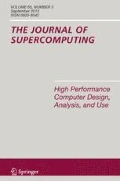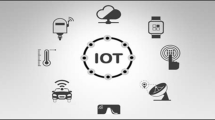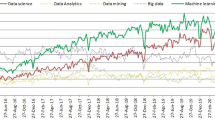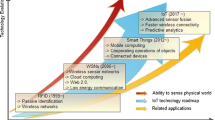Abstract
With the proliferation of technology, a system of connected and interconnected devices, henceforth referred to as Internet of Things, is emerging as a viable method for automated interactions between users and environment in day-to-day life. However, such proliferation leads to an impractical task with respect to interactions among humans and devices. The major reason behind this impractical task is that domain of human’s eye for interaction is limited and devices have their own obligations and prohibitions in context. Motivated by this observation, the paper has proposed four-layered framework, namely, Optimized Clustering-based Discovery Framework on Internet of Things (OCDF-IoT), that (1) automatically discovers resources and their associated services using ontology, (2) governs resources using knowledge formation and representation, (3) provides efficient procedures to index resources on the basis of maximum similarity match, and (4) delegates the selection of the near optimal resource among indexed resources. The framework’s efficiency is evaluated using toll datasets that are gathered from Shambhu Toll Plaza, Panipat–Jalandhar section, Haryana, India. The obtained results support the framework’s efficacy providing more accurate similarity searches, consuming less search time. It is found that framework is stable in providing accurate erred parametric resources and helps in finding the rightful resource with computation of maximum resources. The framework takes minimum CPU throughput for processing queries and increases CPU’s efficiency with less load on server.




















Similar content being viewed by others
Abbreviations
- \(D_{L}\) :
-
Description logics
- TBox :
-
Terminology
- ABox :
-
Assertions
- \(C_{k_{i}}\) :
-
Concept
- \(D_{m}(C_{k_{i}})\) :
-
Domain of concept
- \(M_{R}\) :
-
Semantic distance
- \(R_{N}^{+}\) :
-
Positive real number
- \(SS_{d}\) :
-
Sum of subsume distance
- \(DF_{d}\) :
-
Definition distance
- \(C_{s}\) :
-
Class
- \(DS_{c}\) :
-
Direct superclass
- \(RS_{c}\) :
-
Restrictions
- SUP :
-
Superclass
- \(S_{P}\) :
-
Transitive
- \(R_{c}\) :
-
Resource
- \(wt_{R_{c},l}\), \(wt_{UQ,l}\) :
-
Weights
- \(m_{l}\) :
-
Term
- \(max\left( sim(R_{c}, UQ)\right)\) :
-
Resources with maximum attribute match
- \(Y_{m}\) :
-
Record list
- \(M_{max}\) :
-
Resources
- s :
-
LNN Distance
- \(\varrho\) :
-
Density
- q :
-
Centered resource
- \(Y_{j}\) :
-
Resource set
- G :
-
Degree of membership
- \(B_{j, l}\) :
-
Dissimilarity measurement
- \(\beta\) :
-
Lagrangian multiplier
- \(CBO_{m}\) :
-
Combinatorial optimization model
- \(I_{p}\) :
-
Search space
- \(idx_{i}\) :
-
Discrete best resources
- \(f_{x}\) :
-
Objective function
- \(\varTheta\) :
-
Attributes
- \(P_{v_{s}}\) :
-
Pheromone value
- \(Slc_{p}\) :
-
Solution component
- \(\kappa _{s}\) :
-
Heuristic value
- \(SS_{upd}\) :
-
Solution set
- \(\chi\) :
-
Pheromone decay coefficient
- O(N):
-
Total iterations
- AFKM :
-
Agglomerative Fuzzy K-Means
- ACO :
-
Ant colony optimization
- ABC :
-
Artificial bee colony
- Bar-ID :
-
Barcode Number
- BGA :
-
Binary genetic algorithm
- BS :
-
Bubble sort
- CCSA :
-
Cluster center selection algorithm
- CoAP :
-
Constrained Application Protocol
- CoRE :
-
Constrained RESTful Environments
- CASOF-IoT :
-
Context Aware Search Optimization Framework on Internet of Things
- CA :
-
Cultural algorithm
- DL :
-
Discovery layer
- DNS :
-
Domain name system
- ETC :
-
Electronic toll connection
- ENO :
-
Escape nearest outlier
- FCM :
-
Fuzzy c-means
- FKM :
-
Fuzzy k-means
- GWO :
-
Gray wolf optimizer
- HGAPSO :
-
Hybrid genetic algorithm and particle swarm optimization
- IRIF-IoT :
-
Intelligent Resource Inquisition Framework on Internet of Things
- ITS :
-
Intelligent transport system
- IoT :
-
Internet of Things
- IAFKM :
-
Iterative agglomerative fuzzy k-means
- IGD :
-
Iterative gradient descent
- KQML :
-
Knowledge query and manipulation
- LNN :
-
L-nearest neighbors
- 6LoWPAN :
-
Low-power wireless personal area networks
- M2M :
-
Machine-to-machine
- MDS :
-
Molecular dynamics simulations
- OCDF-IoT :
-
Optimized clustering-based discovery framework on Internet of Things
- OAS :
-
Order acceptance and scheduling
- QAP :
-
Quadratic assignment problem
- RBFN :
-
Radial basis function network
- RFID :
-
Radio frequency identification
- REST :
-
REpresentational State Transfer
- RDF :
-
Resource description framework
- SMEBG :
-
Semantic Matchmaking Engine using Bipartite Graph
- SAL :
-
Sensor actuator layer
- TS :
-
Tabu search
- TEDI :
-
Traffic network editor
- trans-ID :
-
Transaction IDentification
- URI :
-
Universal Resource Identifier
- UAV :
-
Unmanned autonomous vehicles
- UDP :
-
User Datagram Protocol
- UQ :
-
User query
- vehicle-ID :
-
Vehicle registration IDentification
- VM :
-
Virtual machine
- OWL :
-
Web Ontology Language
References
Gartner, Gartner’s hype cycle special report for 2014 (2014) https://www.gartner.com/newsroom/id/2819918
Datta SK, Bonnet C (2016) Describing things in the internet of things: From core link format to semantic based descriptions. In: 2016 IEEE International Conference on Consumer Electronics-Taiwan (ICCE-TW). IEEE, pp 1–2
Datta SK, Da Costa RPF, Bonnet C (2015) Resource discovery in internet of things: current trends and future standardization aspects. In: 2015 IEEE 2nd World Forum on Internet of Things (WF-IoT). IEEE, pp 542–547
Zaslavsky A, Jayaraman PP (2015) Discovery in the internet of things: the internet of things (ubiquity symposium), Ubiquity 2015, pp 2:1–2:10
Shafiq MZ, Ji L, Liu AX, Pang J, Wang J (2012) A first look at cellular machine-to-machine traffic: large scale measurement and characterization. ACM SIGMETRICS Perform Eval Rev 40:65–76
Delicato FC, Pires PF, Batista T (2017) The activities of resource discovery and resource estimation. Springer, Cham, pp 33–44. https://doi.org/10.1007/978-3-319-54247-8_4
Omar NA, Kasim S, Fudzee MFM (2019) A review on feature based approach in semantic similarity for multiple ontology. In: Proceedings of the International Conference on Data Engineering 2015 (DaEng-2015). Springer, pp 457–465
Jiang W, Lin Y, Li Y (2018) Concept alignment of product taxonomies based on semantic similarity. In: 2018 IEEE 3rd International Conference on Cloud Computing and Big Data Analysis (ICCCBDA). IEEE, pp 517–521
Singh N (1993) A common LISP API and facilitator for ABSI: version 2.0. 3, Technical Report, Technical Report logic-93-4, Logic Group, Computer Science Department, Stanford University
Sycara K, Widoff S, Klusch M, Lu J (2002) Larks: dynamic matchmaking among heterogeneous software agents in cyberspace. Auton Agents Multi-agent Syst 5:173–203
Nodine M, Bohrer W, Ngu AHH (1999) Semantic brokering over dynamic heterogeneous data sources in InfoSleuth/sup TM. In: Proceedings of 15th International Conference on Data Engineering. IEEE, pp 358–365
Tangmunarunkit H, Decker S, Kesselman C (2003) Ontology-based resource matching in the grid-the grid meets the semantic web. In: International Semantic Web Conference, volume 2870. Springer, pp 706–721
Sharma Y, Goyal N (2008) An efficient multi-component indexing embedded bitmap compression for data reorganization. Inf Technol J 7:160–164
Bharti M, Kumar R, Saxena S (2018) Clustering-based resource discovery on Internet-of-Things. Int J Commun Syst 31:e3501
Fanian F, Rafsanjani MK (2019) Cluster-based routing protocols in wireless sensor networks: a survey based on methodology. J Netw Comput Appl 142:111–142
Jindal H, Kasana SS, Saxena S (2016) A novel image zooming technique using wavelet coefficients. In: Proceedings of the International Conference on Recent Cognizance in Wireless Communication & Image Processing. Springer, pp 1–7
Dunkels A, Gronvall B, Voigt T (2004) Contiki-a lightweight and flexible operating system for tiny networked sensors. In: 29th Annual IEEE International Conference on Local Computer Networks. IEEE, pp 455–462
Cao Q, Abdelzaher T, Stankovic J, He T (2008) The liteos operating system: towards unix-like abstractions for wireless sensor networks. In: 2008 International Conference on Information Processing in Sensor Networks (IPSN 2008). IEEE, pp 233–244
Mourya G, Jindal H, Saxena S (2015) Software perspective to underwater acoustic sensors network. In: 2015 1st International Conference on Next Generation Computing Technologies (NGCT). IEEE, pp 187–191
Gantz J, Reinsel D (2007) The digital universe in 2020: big data, bigger digital shadows, and biggest growth in the far east. IDC iView: IDC Anal Future 2012:1–16
Jindal H, Saxena S, Singh S (2014) Challenges and issues in underwater acoustics sensor networks: a review. In: 2014 International Conference on Parallel, Distributed and Grid Computing. IEEE, pp 251–255
Almagbile A (2019) Estimation of crowd density from uavs images based on corner detection procedures and clustering analysis. Geo-spatial Inf Sci 22:23–34
Jindal H, Saxena S, Kasana SS (2017) Sewage water quality monitoring framework using multi-parametric sensors. Wirel Pers Commun 97:881–913
Zhu C, Miao D (2019) Influence of kernel clustering on an RBFN. CAAI Trans Intell Technol 4:255–260
Jindal H, Kasana SS, Saxena S (2018a) Underwater pipelines panoramic image transmission and refinement using acoustic sensors. International J Wavelets Multiresolut Inf Process 16:1850013
Jindal H, Saxena S, Kasana SS (2018b) A sustainable multi-parametric sensors network topology for river water quality monitoring. Wirel Netw 24:3241–3265
Mousavi S, Lee D, Griffin T, Steadman D, Mockus A (2020) Collaborative learning of semi-supervised clustering and classification for labeling uncurated data. arXiv preprint arXiv:2003.04261
Jindal H (2019) Procreation of energy efficient topologies for data transmission in underwater wireless sensor network. Ph.D. thesis, TIET
Aljarah I, Mafarja M, Heidari AA, Faris H, Mirjalili S (2020) Clustering analysis using a novel locality-informed grey wolf-inspired clustering approach. Knowl Inf Syst 62:507–539
Mander K, Jindal H (2017) An improved image compression–decompression technique using block truncation and wavelets. Int J Image Graph Signal Process 9:17
Manyika J, Chui M, Bughin J, Dobbs R, Bisson P, Marrs A (2013) Disruptive technologies: advances that will transform life, business, and the global economy, vol 180. McKinsey Global Institute, San Francisco
Kumar CA, Srinivas S (2010) Concept lattice reduction using fuzzy k-means clustering. Expert Syst Appl 37:2696–2704
Rayward-Smith V (2000) Fuzzy cluster analysis: methods for classification, data analysis and image recognition. J Oper Res Soc 51:769–769
Webster F (1958) Traffic signal settings, road research technical paper no. 39, Road Research Laboratory
Jindal H, Singh H, Bharti M (2018) Modified cuckoo search for resource allocation on social Internet-of-Things. In: 2018 Fifth International Conference on Parallel, Distributed and Grid Computing (PDGC). IEEE, pp 465–470
Robertson DI (1969) ‘Tansyt’ method for area traffic control. Traffic Eng Control 8(8)
Wallace CE, Courage K, Reaves D, Schoene G, Euler G (1984) TRANSYT-7F user’s manual. Technical Report
Baskan O, Haldenbilen S, Ceylan H, Ceylan H (2009) A new solution algorithm for improving performance of ant colony optimization. Appl Math Comput 211:75–84
Kaur S, Jindal H (2017) Enhanced image watermarking technique using wavelets and interpolation. Int J Image Graph Signal Process 11:23
Li D, Li K, Liang J, Ouyang A (2019) A hybrid particle swarm optimization algorithm for load balancing of MDS on heterogeneous computing systems. Neurocomputing 330:380–393
Shuka R, Brehm J (2019) A parallel adaptive swarm search framework for solving black-box optimization problems. In: International Conference on Architecture of Computing Systems. Springer, pp 100–111
Dokeroglu T, Sevinc E, Cosar A (2019) Artificial bee colony optimization for the quadratic assignment problem. Appl Soft Comput 76:595–606
Chaurasia SN, Kim JH (2019) An artificial bee colony based hyper-heuristic for the single machine order acceptance and scheduling problem. In: Decision science in action. Springer, pp 51–63
Mittal A, Jindal H (2017) Novelty in image reconstruction using DWT and CLAHE. Int J Image Graph Signal Process 9:28
Dixit A, Kumar S, Pant M, Bansal R (2019) CA-DE: Hybrid algorithm based on cultural algorithm and DE. In: Machine Intelligence and Signal Analysis. Springer, pp 185–196
Jindal H, Saxena S, Kasana SS (2017) Triangular pyramidal topology to measure temporal and spatial variations in shallow river water using ad-hoc sensors network. Ad Hoc Sens Wirel Netw 39:1–35
Mohammadhosseini M, Haghighat AT, Mahdipour E (2019) An efficient energy-aware method for virtual machine placement in cloud data centers using the cultural algorithm. J Supercomput 75:6904–6933
Saxena S, Mehta D, Kaur J, Jindal H (2014) Acoustic communication characteristics in UWDBCSN. In: 2014 International Conference on Parallel, Distributed and Grid Computing. IEEE, pp 176–180
Li MJ, Ng MK, Cheung Y-M, Huang JZ (2008) Agglomerative fuzzy k-means clustering algorithm with selection of number of clusters. IEEE Trans Knowl Data Eng 20:1519–1534
Bharti M, Saxena S, Kumar R (2017) Intelligent resource inquisition framework on internet-of-things. Comput Electr Eng 58:265–281
Bharti M, Kumar R, Saxena S (2018) Context-aware search optimization framework on the Internet of Things. Concurr Comput Pract Exp 30:e4426
Severi P, Rohrer E, Motz R (2019) A description logic for unifying different points of view. In: Iberoamerican Knowledge Graphs and Semantic Web Conference. Springer, pp 17–32
Shelby Z (2012) Constrained restful environments (core) link format
Fielding R (2000) Representational state transfer. Architectural Styles and the Design of Netowork-based Software. Architecture, pp 76–85
Kushalnagar N, Montenegro G, Schumacher C et al (2007) IPv6 over low-power wireless personal area networks (6LoWPANs): overview, assumptions, problem statement, and goals
Fielding R, Gettys J, Mogul J, Frystyk H, Masinter L, Leach P, Berners-Lee T (1999) Hypertext transfer protocol–http/1.1
Nottingham M (2010) RFC5988: Web linking, Internet Engineering Task Force (IETF) Request for Comments
Shelby Z, Hartke K, Bormann C, Frank B (2012) Constrained application protocol (CoAP), draft-ietf-core-coap-13. The Internet Engineering Task Force-IETF, Orlando
Freed N, Borenstein N (1996) Multipurpose internet mail extensions (MIME) part one: format of internet message bodies
Shelby Z (2012) Core link format, draft-ietf-core-link-format-11, Internet draft, IETF 2012 (in progress)
Compton M, Barnaghi P, Bermudez L, GarcíA-Castro R, Corcho O, Cox S, Graybeal J, Hauswirth M, Henson C, Herzog A et al (2012) The SSN ontology of the W3C semantic sensor network incubator group. J Web Semant 17:25–32
Moussa M, Măndoiu II (2018) Single cell RNA-seq data clustering using TF-IDF based methods. BMC Genom 19:127
Mockapetris P (1987) RFC-1034 domain names-concepts and facilities. Network Working Group, 55
Kennedy J (2011) Particle swarm optimization. In: Encyclopedia of Machine Learning. Springer, pp 760–766
Author information
Authors and Affiliations
Corresponding author
Additional information
Publisher's Note
Springer Nature remains neutral with regard to jurisdictional claims in published maps and institutional affiliations.
Rights and permissions
About this article
Cite this article
Bharti, M., Jindal, H. Optimized clustering-based discovery framework on Internet of Things. J Supercomput 77, 1739–1778 (2021). https://doi.org/10.1007/s11227-020-03315-w
Published:
Issue Date:
DOI: https://doi.org/10.1007/s11227-020-03315-w




